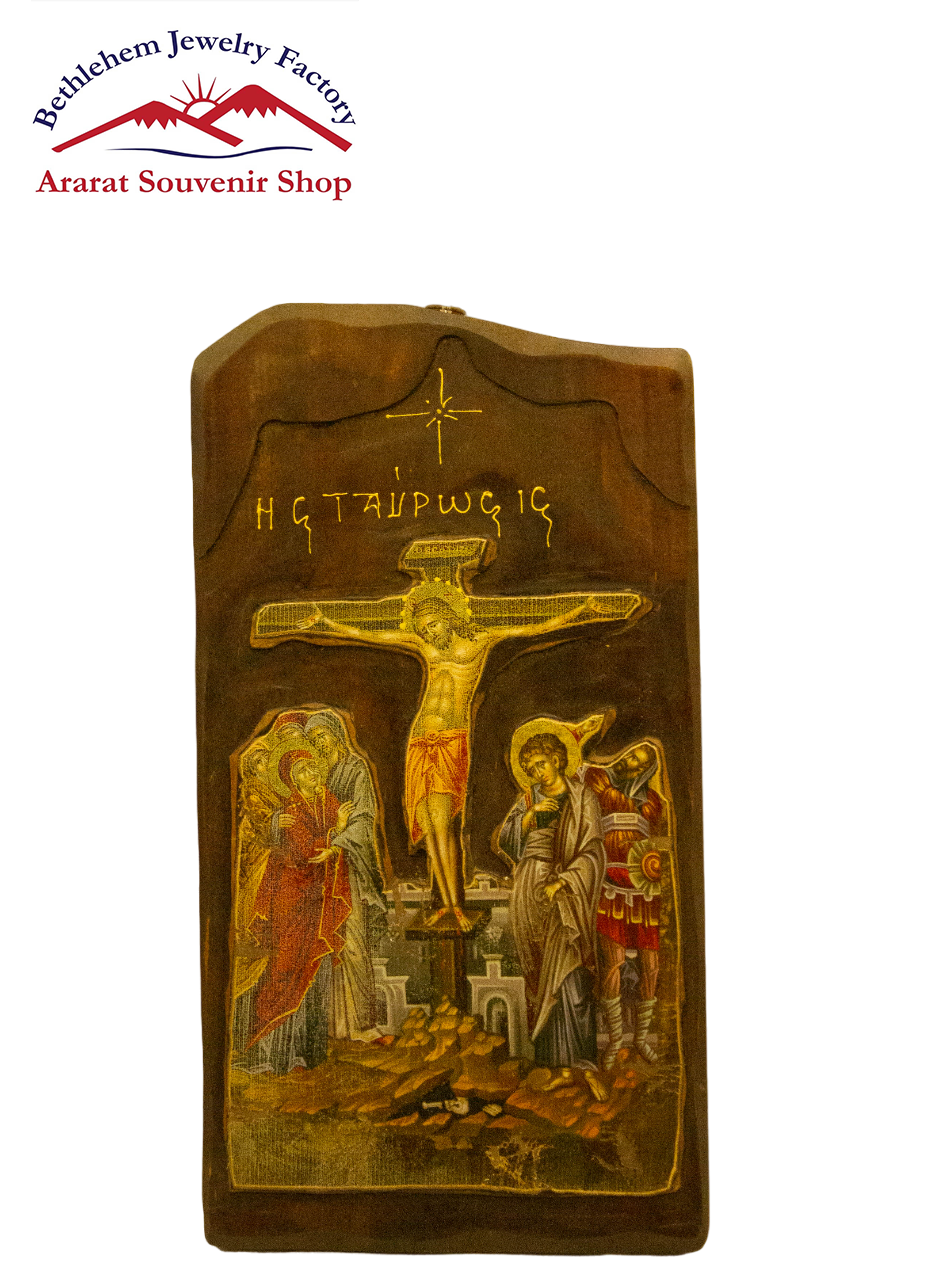


Crucifixion of Christ Icon
305 $
Crucifixion of Christ Icon
Product specifications:
- Delivery is available within 15 days
- Bethlehem Jewelry Factory Holy Land, Israel
-
Material: Olive wood
Weight : 5.5LB (2480gr)
Length: 20 inches (520mm)
Width: 10.5 inches (270mm)
Height: 1 inches (30mm)
- Resizable: No
- Made in the Holy Land
Crucifixion of Christ Icon
The crucifixion of Christ is one of the most pivotal events in Christian theology and is profoundly represented in religious art, particularly in the form of icons. The crucifixion icon, often referred to as the “Crucifix,” encapsulates the depth of Christ’s suffering, the gravity of sin and redemption, and the love of God for humanity. These icons serve not just as artistic expressions but as vital tools for devotion, reflection, and theological contemplation.
In a crucifixion icon, Jesus is typically depicted nailed to the cross, which is often shown with a background that emphasizes the somber significance of the moment. The image may include other figures such as the Virgin Mary, Saint John the Evangelist, and occasionally centurions or mourners. Each character surrounding Christ contributes to the overall narrative and evokes a spectrum of human emotions, from despair to hope. Mary, for instance, is frequently portrayed in a position of anguish, embodying the pain of a mother witnessing her son’s suffering. This intimate portrayal connects believers to the human aspect of Christ’s sacrifice, enhancing empathy and a personal connection to the Passion.
The composition of the icon is rich in symbolism, often conveying multiple layers of meaning. The cross itself, a symbol of both suffering and hope, becomes the central axis of the artwork. The vertical beam represents the connection between heaven and earth, while the horizontal beam signifies the relationship between humanity and God. In some Eastern Orthodox icons, Christ is depicted not as a figure of despair but as a regal, triumphant king, illustrating the belief that, through his sacrifice, he conquers sin and death. This duality captures the essence of Christian faith: that through suffering comes redemption, and from death springs eternal life.
Colors and details are crucial in crucifixion icons. Red may symbolize Christ’s blood, signifying sacrifice, while gold or bright colors in the background can represent the divine light of resurrection that follows. Sometimes the crucified Christ is depicted without a halo, emphasizing his human suffering, while at other times, a faint halo may signal his divine nature, reminding viewers that he is both truly God and truly man. The positioning of Christ’s body is also steeped in meaning; the way his arms are stretched out conveys the depth of his love and willingness to embrace humanity in its totality, welcoming all into fellowship with God.
The crucifixion icon serves multiple functions within the context of worship and personal devotion. In church settings, such icons can be focal points for prayer, allowing congregants to meditate on the significance of Christ’s sacrifice. They provide a visual narrative that enriches liturgy, particularly during the observance of Good Friday and the Easter season. The act of venerating the crucifixion icon—whether through kissing the icon, lighting candles, or offering prayers—becomes an act of communion with the mystery of Christ’s death and resurrection.
The theological implications of the crucifixion are profound. The cross is emblematic of the atonement and the belief that Christ willingly accepted the penalty for humanity’s sins. As articulated in verses such as Isaiah 53:5, “But he was pierced for our transgressions, he was crushed for our iniquities; the punishment that brought us peace was on him, and by his wounds, we are healed.” In this light, the crucifixion icon transcends its representation of suffering, becoming a powerful testament to God’s love and grace.
Furthermore, the crucifixion icon invites reflection on broader themes of suffering, sacrifice, and hope within the Christian journey. For many believers, the image serves as a poignant reminder of personal crosses they bear. It provides solace in times of grief and pain, framing human struggle within divine purpose. By contemplating the crucifixion, individuals are encouraged to find meaning in their own suffering and to seek transformation through Christ’s example.
In art history, the crucifixion icon has taken various forms across cultures and epochs, reflecting distinct theological emphases. From the stark and emotive Byzantine icons to the more dramatic and realistic depictions of the Renaissance, the icon has evolved, yet its core message remains unchanged: the profound significance of Christ’s sacrifice and its implications for redemption and salvation.
Finally, the crucifixion icon stands as a bridge between the past and the present, connecting contemporary believers with the profound mystery of the Passion. It invites faithful participation in the narrative of Jesus Christ, calling individuals to contemplate their relationship with the cross and, ultimately, to embrace the promise of resurrection. Through the lens of this sacred imagery, the crucifixion becomes not just a moment of despair but a profound declaration of love, hope, and the transformative power of faith. In this way, the crucifixion icon remains an enduring focal point of Christian spirituality, drawing believers into deeper communion with the heart of the Gospel.









Reviews
There are no reviews yet.